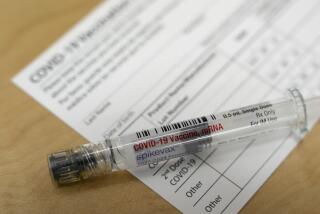Olympus scopes may have infected more patients, Seattle health agency says
More patients across the country may have been infected by medical scopes manufactured by Olympus Corp. than previously thought, health officials warned Monday.
Olympus’ scopes are at the center of a string of recent endoscope-related superbug outbreaks that include Ronald Reagan UCLA Medical Center and Cedars Sinai Medical Center, as well as an earlier case at Virginia Mason Medical Center in Seattle.
“We suspect endoscope-associated transmission of bacteria is more common than recognized and not adequately prevented by current reprocessing guidelines,” said Kristen Wendorf, a doctor at King County’s public health department in Seattle and lead author of a new report on the city’s 10-month outbreak that ended in August 2013.
The health officials called it “especially disturbing” that the Seattle hospital had meticulously followed the company’s instructions for cleaning the scopes but still had a superbug outbreak that infected 32 patients.
In all three hospital outbreaks, patients undergoing a procedure with Olympus’ device known as a duodenoscope were infected with bacteria that almost no antibiotics can fight. Similar deadly outbreaks have recently occurred in several other states.
The report said that Virginia Mason’s outbreak was detected only after the county health department asked hospitals to send it samples of a superbug known as CRE, or carbapenem-resistant Enterobacteriaceae, that had sickened any of their patients.
With further tests, the county’s lab found that three patients at Virginia Mason had been infected with CRE that had the same distinct genetic markers — leading to an investigation of the infections’ source.
Wendorf said it was likely the outbreak would have gone undetected if the county had not gathered the CRE samples and looked for connections. Few states have done similar surveillance to find outbreaks, she said.
California does not require hospitals to report CRE infections, which can kill 50% of patients.
It wasn’t until last week that Olympus sent an urgent update to U.S. hospitals that its instructions for cleaning the devices weren’t adequate and that extra disinfection steps were needed.
The company did not respond Monday to a request for comment.
After investigators found that Virginia Mason patients continued to be infected despite proper cleaning of the scopes, the hospital sent its eight duodenoscopes to Olympus for review, the report said.
The company found that seven of the eight scopes had hidden mechanical defects that could have helped spread the bacteria, the report said.
The scopes were overhauled by Olympus and sent back to the hospital. But even after that maintenance, some of the scopes couldn’t be cleaned after they were used in another patient, the report said.
In all, 32 patients at Virginia Mason were infected with the CRE. Eleven of those patients died, although the researchers could not definitely tie the deaths to the infections. All the patients suffered from pancreatic cancer, colon cancer or other serious illnesses.
Virginia Mason now manually cleans all the scopes, taking measures that go beyond Olympus’ instructions. The hospital then quarantines the devices for 48 hours, which allows its staff to get the results of culture tests aimed at finding any remaining bacteria.
The hospital is finding that 3% of the scopes are still dirty after that process — which leads to a repeat of the cleaning steps.
“No scope is used at Virginia Mason until the cultures are negative,” said Gale Robinette, a spokesman for the medical center.
The new report was written by researchers at the King County health department, Washington state’s health department, Virginia Mason and other institutions.
The device is a long flexible scope that goes down a patient’s throat during a procedure known as ERCP, or endoscopic retrograde cholangiopancreatography.
Olympus is the dominant supplier of the scopes, which are also made by Pentax and Fujifilm.
Twitter: @melodypetersen
Times staff writer Chad Terhune contributed to this report.







